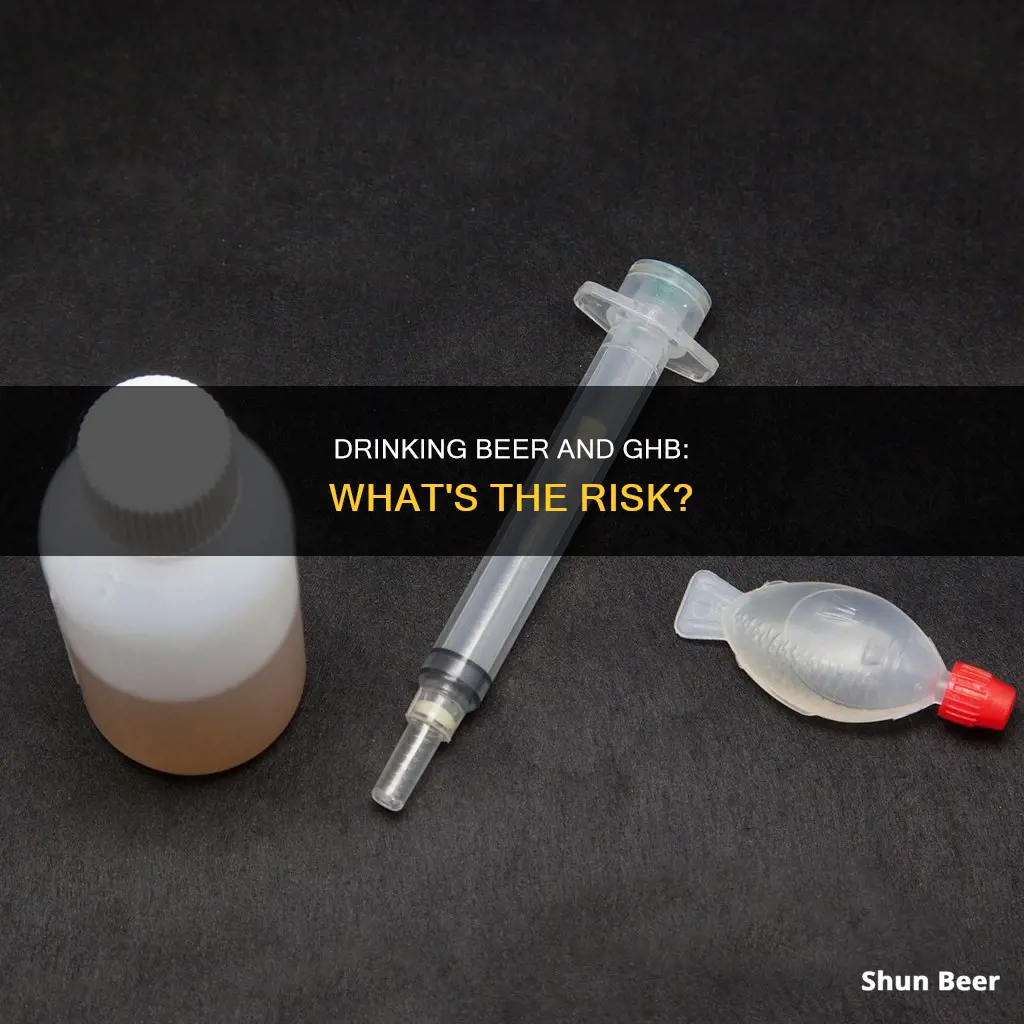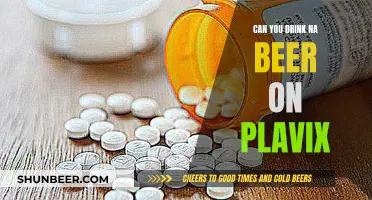
Mixing Gamma-Hydroxybutyrate (GHB) and alcohol can be extremely dangerous and even life-threatening. Both substances are central nervous system depressants, which slow down vital life-sustaining functions of the central nervous system and have significant mind-altering effects. When mixed, the sedative and depressant effects of both substances are amplified, increasing the risk of accidents, injuries, respiratory depression, and overdose. The combination of GHB and alcohol can also lead to severe and unpredictable side effects, including gastrointestinal disturbances, hypotension, and decreased oxygen saturation. Additionally, both substances are addictive, and regular use can lead to physical dependence and withdrawal symptoms. Seeking help from a professional treatment program is crucial to safely manage detoxification and address the underlying causes of substance use.
| Characteristics | Values |
|---|---|
| Is it safe to drink 2 beers and GHB? | No, it is not safe to mix GHB and alcohol. |
| Why is it dangerous? | GHB and alcohol are both central nervous system depressants, which means they can amplify each other's effects, including drowsiness, impaired motor function, slowed thinking, and slowed breathing. |
| What are the risks? | Mixing GHB and alcohol increases the risk of accidents, injuries, respiratory depression, and overdose. |
| What are the signs of addiction? | Irritability, mood swings, low energy, lack of motivation, depression, anxiety, paranoia, withdrawal from social activities, behavioural changes, and risky behaviour. |
| How to get help? | Seek professional help from a treatment facility or helpline. |
What You'll Learn
- GHB and alcohol are both central nervous system depressants
- GHB and alcohol can amplify each other's effects
- Mixing GHB and alcohol can lead to severe and unpredictable side effects
- GHB and alcohol can increase the risk of accidents and injuries
- GHB withdrawal can be dangerous and should be done under medical supervision

GHB and alcohol are both central nervous system depressants
GHB (gamma-hydroxybutyrate or gamma-hydroxybutyric acid) is a central nervous system depressant initially developed as an anaesthetic. It is known as a 'party drug' and often associated with raves and clubs. It is also referred to as 'liquid ecstasy' or 'Georgia Home Boy'. GHB is distributed as a clear and colourless liquid or a white powder that is dissolved in liquid.
Alcohol is also a central nervous system depressant. It is a legal and socially accepted substance in many cultures.
Both GHB and alcohol slow down vital life-sustaining functions of the central nervous system. They can affect concentration and coordination and slow down a person's ability to respond to unexpected situations. In larger doses, they can cause drowsiness, vomiting, unconsciousness and death.
When GHB and alcohol are mixed, the effects of both substances are heightened, and a person may become intoxicated faster and be more vulnerable to negative consequences. The sedative and depressant effects are amplified, and the risk of overdose is increased. An overdose involving GHB and alcohol can cause respiratory failure, coma, or death.
The combination of GHB and alcohol can be extremely dangerous and even life-threatening. It is important to seek help if you or someone you know is struggling with substance use or addiction.
Beer Belly Blues: Stomach Pain After Drinking Beer, Why?
You may want to see also

GHB and alcohol can amplify each other's effects
GHB (gamma-hydroxybutyrate or gamma-hydroxybutyric acid) and alcohol are central nervous system depressants. This means that they slow down vital life-sustaining functions of the central nervous system, such as heart rate, respiration, and blood pressure. When combined, the sedative and depressant effects of both substances are amplified.
GHB and alcohol both act on parts of the brain that control movement and coordination, memory and decision-making abilities, and mood regulation. They elevate levels of neurotransmitters such as dopamine and gamma-aminobutyric acid (GABA). High levels of dopamine in the brain can contribute to feelings of pleasure and intoxication, while elevated GABA levels suppress the "fight-or-flight" reaction and slow down central nervous system functions. When mixed, the side effects of both substances are heightened, and a person may become intoxicated faster and be more vulnerable to negative consequences.
The combination of GHB and alcohol can lead to sedation, amnesia (memory loss), and a potentially life-threatening overdose. An overdose involving GHB and alcohol can cause respiratory failure, coma, or death. Other symptoms of overdose include lowered body temperature, weak pulse, irregular heart rate, extreme mental confusion, and possible psychosis.
In addition, mixing GHB and alcohol can increase the risk of addiction. Both substances are addictive, and when used regularly, the brain can become dependent on them. When combined, physical dependence may develop more quickly than if only one substance is used. The brain expects the chemical interference in its brain chemistry and struggles to remain "balanced" without them, leading to challenging withdrawal side effects. GHB and alcohol withdrawal can be intense and life-threatening, making it more likely that a person will continue to use these substances to avoid the negative consequences of cessation.
Therefore, it is essential to seek professional help if struggling with GHB and alcohol addiction. Treatment typically begins with medical detox to safely remove the drugs from the body, followed by residential treatment to develop healthy habits, cope with cravings, and minimize the risk of relapse.
Beer Drinking in Yellowstone: What's Allowed?
You may want to see also

Mixing GHB and alcohol can lead to severe and unpredictable side effects
GHB, or gamma-hydroxybutyric acid, is an illegal drug often manufactured in illicit laboratories and distributed at clubs and raves. It is known to lower inhibitions, increase passivity, and heighten libido, making it a common drug used in sexual assaults. Alcohol, on the other hand, is a legal and widely consumed substance that can produce a pleasant "buzz" at low levels and impair rational thought processes, movement, coordination, and memory function at higher levels.
When mixed, GHB and alcohol can cause a range of severe side effects, including slowed breathing, lower body temperature, and vomiting. The combination can also lead to sedation, amnesia, and a potentially life-threatening overdose. An overdose involving GHB and alcohol can cause respiratory failure, coma, or even death. Additionally, the risk of addiction is heightened when these two substances are used together, as physical dependence may develop more quickly.
The withdrawal symptoms associated with GHB and alcohol can be serious and difficult to manage without professional help. Detoxification, counseling, and therapy are often necessary steps in the treatment of GHB and alcohol addiction. It is crucial to seek help if you or someone you know is struggling with substance use involving GHB and alcohol.
Gluten Allergy and Beer: Is It Safe to Drink?
You may want to see also

GHB and alcohol can increase the risk of accidents and injuries
GHB, or gamma-hydroxybutyric acid, is an illegal drug that is often manufactured in illicit laboratories and distributed at clubs and raves. It is a central nervous system depressant initially developed as an anesthetic. It is also a depressant drug that can lower anxiety and lead to drowsiness and mental confusion. In large amounts, it may cause hallucinations, aggression, and overexcitement.
Alcohol is also a central nervous system depressant. It dampens the body's stress response by lowering anxiety and body temperature and slowing down heart rate, respiration, and blood pressure. In larger amounts, alcohol impedes rational thought processes, movement and coordination, and memory function while having sedative effects.
The combination of GHB and alcohol can be extremely dangerous and even life-threatening. Both substances slow down vital life-sustaining functions of the central nervous system and have significant mind-altering effects. The sedative and depressant effects of both substances are amplified when they are mixed, and a person may be more prone to accidents and injuries. They may be more likely to fall down and get hurt, and their risk of respiratory depression increases.
The risk of overdose also increases when GHB is added to alcohol. An overdose involving GHB and alcohol can cause a person to struggle to breathe, potentially resulting in respiratory failure, coma, or death. Additional symptoms of overdose can include lowered body temperature, weak pulse, irregular heart rate, extreme mental confusion, and loss of consciousness. Overdose is a medical emergency, and first responders must be made aware that multiple substances are involved.
It is important to seek help if you or someone you know is struggling with substance use. Treatment for GHB and alcohol addiction typically begins with medical detoxification, followed by residential treatment to develop healthy habits, combat cravings, and minimize the risk of relapse.
Beer and Cancer: What's the Daily Drinking Risk?
You may want to see also

GHB withdrawal can be dangerous and should be done under medical supervision
Chronic GHB use can lead to tolerance, dependence, and addiction. Tolerance occurs when the body becomes less responsive to a given dose of GHB, leading users to increase their dosage over time to achieve the desired effects. Dependence occurs when the body becomes so accustomed to GHB that it cannot function properly without it, leading to severe withdrawal symptoms. These symptoms can include increased heart rate, increased blood pressure, tremors, anxiety, insomnia, and possible psychotic thoughts.
Withdrawal from GHB can be severe and may last up to 2 weeks, with some symptoms persisting for months afterward. Unsupervised withdrawal has been known to lead to death in some cases, and psychosis and severe agitation have also been reported. The severity of withdrawal symptoms and the timeline of effects depend on the level and duration of GHB use prior to quitting. Heavy GHB users are at a higher risk of experiencing more serious withdrawal effects.
Due to the potential dangers and challenges associated with GHB withdrawal, it is strongly recommended to seek professional medical assistance. A medical detox protocol, supervised by trained professionals in a controlled environment, can help ensure a safer and more effective withdrawal process. This typically involves a highly structured program where individuals are closely monitored as the drugs process out of their system. Medications are often a critical component of medical detox, as they can help alleviate withdrawal symptoms and gradually reduce the body's dependence on the substance.
Enjoying Beer at VA Beach: What You Need to Know
You may want to see also
Frequently asked questions
No, it is not safe to drink 2 beers and take GHB. Both substances are central nervous system depressants and can amplify each other's effects, leading to drowsiness, impaired motor function, slowed thinking, and even respiratory failure or death.
Mixing alcohol with GHB can lead to a range of adverse effects, including gastrointestinal disturbances, hypotension, decreased oxygen saturation, and a potentially life-threatening overdose. The combination can also increase the risk of accidents and injuries due to impaired coordination and judgment.
It is recommended to wait at least 24 hours after taking GHB before consuming alcohol to ensure the drug is completely out of your system and reduce the risk of adverse effects and overdose.
Yes, it is important to prioritize your health and well-being. Alternatives to consider include not taking any substances or opting for healthier options such as smoking weed or engaging in activities like yoga and meditation. Seeking professional help is also an option if you feel that you are struggling with substance use or addiction.







